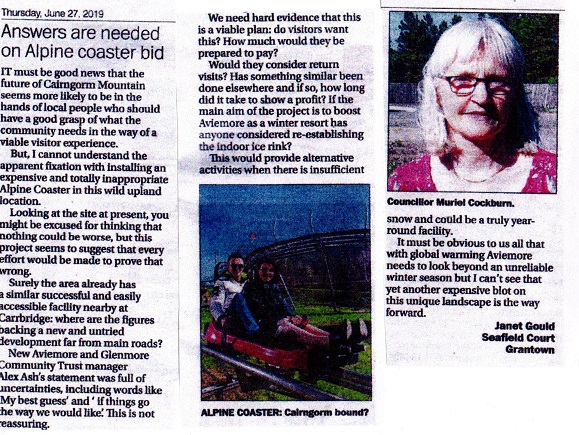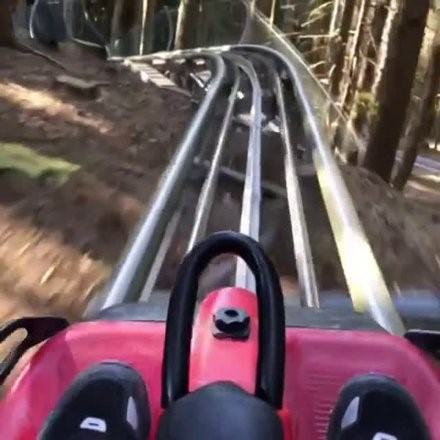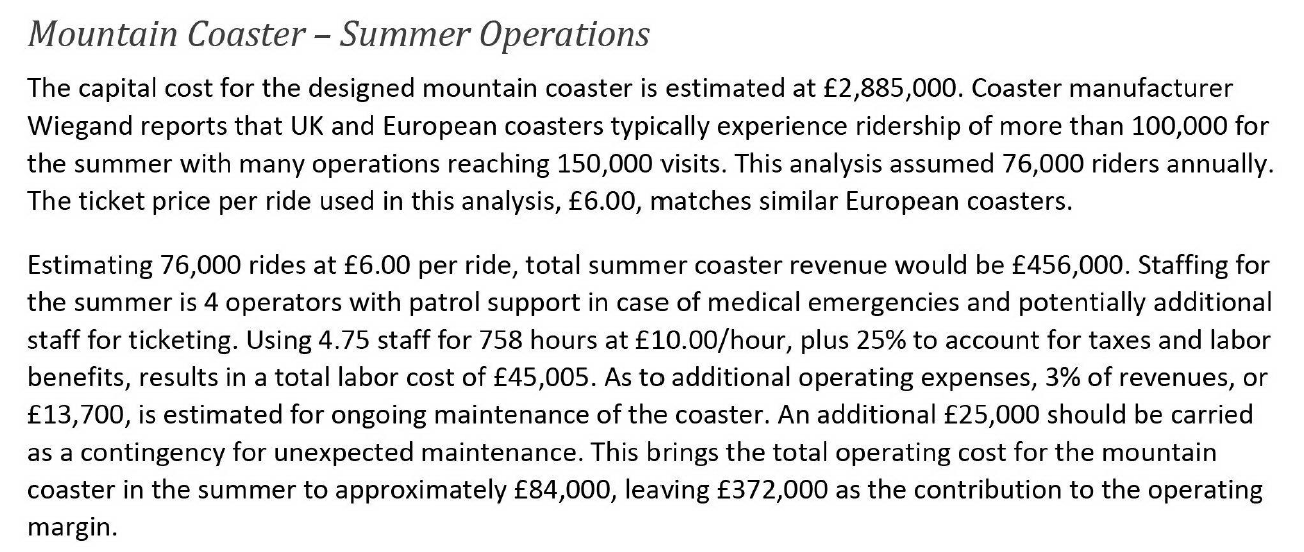
“A mountain coaster is a massive source of income but has to be implemented by the community”.
This was part of a Facebook post on Sunday 23/06/2019, the claim being that the business plan proposed by the Aviemore and Glenmore Community Trust (A&GCT) and the SE Group showed a good profit could be made from the building of an Alpine Coaster. From the A&GCT webpage:
“With a proven high return on investment, a mountain coaster could easily be privately financed etc”.
This post takes a critical look at the claim there will be “a proven high return on investment”.
I will use the figures provided by the SE Group, the international experts engaged by HIE, which are available on the Highlands and Islands Enterprises website (see here), as I am unable to find the A&GCT business plans.
 There would appear to be several omissions from the SE Group report, e.g. the length, vertical drop, top speed, and the time it takes to complete the circuit for the proposed roller coaster. These are all considerations for anyone wanting a thrill, so I will therefore use the figures for the mountain coaster at Zipworld in Wales.
There would appear to be several omissions from the SE Group report, e.g. the length, vertical drop, top speed, and the time it takes to complete the circuit for the proposed roller coaster. These are all considerations for anyone wanting a thrill, so I will therefore use the figures for the mountain coaster at Zipworld in Wales.
Zipworld example
Length 1075m, 365m up and 710m down, max speed 40 kph and a circuit time of about 6 minutes, i.e. 5mins. up 1min. down, just slightly less than the time it takes to go up and ski down Coire Cas. There are restrictions on who can use sleds, with a minimum height of 1.35m and maximum weight of 150kg. Also for single person sled use there is a minimum age of 9yrs+ and for shared sled, 9yrs+ with a second rider from 3yrs – 8yrs.
Pricing at Zip World:- A ticket buys 3 runs of a single sled for £19 off peak (o/p) or £29 peak (p). A shared sled costs £29 o/p, or £39 p, BUT for two adults (whose combined weight must be less than 150kgs) its £38 o/p, £58 p.
Costs, income and net revenue
There are several costs to be taken into consideration :-
(1) design, construction and re-instatement of ground,
(2) daily wages,
(3) daily energy,
(4) annual maintenance,
(5) loss of revenue to the Funicular – something else not mentioned by A&GCT, and
(6) re-wilding to reduce the visual impact.
Then we need to know :-
(1) the estimated number of users/ tickets sold,
(2) the number of runs allowed per ticket,
(3) the cost of a ticket?
All this information will allow us to obtain a figure for the “massive source of income” that some people expect.
The SE Group contains calculations about this on page 78 of their report:-

The figure of £14 for a one minute ride is ridiculous and shows in my opinion how serious the flaws are in the argument, and, the potential revenue does not take into account items (2) – (6) of the costs and is therefore gross not net.
If, however, we look at page 87 of the SE Report, a totally different set of figures are presented:

This shows an expected cost of (a) £2,885,000, an expected revenue of £456,000, an operating cost of £84,000 (18.42% of revenue), leaving an net revenue of (b) £372,000. This is the “massive source of income” that is being promoted. Dividing (a) by (b) gives you the number of years to pay back the initial capital investment, 7.75 years and that is assuming all overheads remain as predicted before the profit can be appreciated.
A copy of an email obtained through a Freedom of Information request reveals that the A&GCT expect a figure of 36,000 visits/ rides at a ticket price of £7.50. This equates to an expected revenue of £270,000 minus an operating cost of approximately £50,000 (18.42% of revenue) leaving a net revenue of £220,000 and a breakeven point for the initial investment of just over 13 years.
Compare that figure to the revenue from skiers using the same visitor number, 36,000 day tickets at nominal price of £37 per day is £1,332,000. Instead of guessing at a price, would it not be base prices on established charges elsewhere, such as Zipworld, but adapt this so that it includes/takes account of the funicular (assuming its repaired)?
This shows that the idea of a mountain coaster being a major revenue earner, in my opinion, is simply “pie in the sky”. The only way it can be justified is if the capital costs for planning and construction were all met by the public purse, another huge waste of public money.
What needs to happen.
Before any decision is made on taking forward the proposals for a mountain coaster, it would be prudent for someone from HIE, with the necessary skills, to approach Zipworld for advice with regards to the variables mentioned above and compare them to the SE Group report. That company has experienced a variety of problems that could completely derail the project, no pun intended. Also while I have shown that the mountain coaster could not be a stand alone business, it has to be remembered that it should be part of a master business plan that has been requested from HIE by the CNPA and others.
Part 2 of my post will be on the environmental issues surrounding a mountain coaster that need to be addressed.

The S E Group report is the classic marketing consultant’s report – packed with words to try to loose the reader and make them believe that the work carried out has been rigorous, but with figures to the discerning reader that appear to be plucked from thin air, but which give HIE the answer they always wanted.
I don’t see any rigorous analysis of the number of days that the coaster could not operate due to weather conditions (winter and summer), far less the number of days customers would even want to use the coaster in bad weather.
Out of a 105 page report, only 6 pages cover the ‘summer experience’ and out of this the back of an envelope financials shown in this article for the coaster appear. There is no declared environmental and financial comparison with other coasters in the UK and Europe – just some so-called ‘typical’ figures from the coaster manufacturer – hardly an un-biased entity. Are there any coasters operating successfully in anything like the severe weather conditions found on Cairn Gorm, and do the remarkably low maintenance costs reflect these sever conditions? The report rushes to propose activities which involve turning Cairn Gorm into a summer adventure park to try to rival Landmark, and does not cover the benefit that a large majority of the summer visitors want – mountain walking, wildlife and the wilderness feeling. To call the S E Group report’s narrative and financials on the coaster and the other summer proposals ‘Mickey Mouse’, is arguably an insult to the cartoon character.
Graham, you’ve made a good start at exposing the inadequacies of the business case. I’m sure there are many more to be flushed out.
Lastly, I was amused by the following words in the executive summary about the funicular:
“The funicular is a major asset for the resort but the over-reliance on it is problematic given its limited capacity and non-skier use. Its susceptibility to closure also hampers the experience for both skiing and non-skiing visitors, and solutions are needed. With improved uplift in place, Cairngorm should explore restricting the funicular to a few types of visitors (i.e., ski school, nonskiers).”
What a mixed message that is! What I take from the words is that the funicular is a liability and if starting from scratch even S E Group would not propose it. However, to keep its customer happy, S E Group says its a major asset, but their words belie it.
Great article.
What this piece of work does is blow the harsh wind of reality regarding investment (wherever it comes from) verses return for the future of the ski area. That has been sadly lacking lately, the most notable stupidly being the latest absurb proposal to build a campervan park at the Ciste ( I can’t help thinking that was a late April fool)
The one thing that really stands out is the fact that developing anything “new” from the top cark park will be difficult and will certainly struggle to stack up financially never mind environmentally.
Over and above all that, the Ski Centre is really up against it just to cover it’s annual costs and maintenance.
Can we have another winter with little or no income and where we pollute the area with the utterly useless snow making machine ? And some might also ask, does it deserve funding from the public purse?
Anyway, the future…..
We need to understand who the visitors are, where they go, and what they are willing / want to spend money on. Unfortunately the financial future of the area does NOT depend on the local outdoor community (of whom I am one) who barely spend anything up there, moan about £2 for parking and then moan louder when the toilets are closed in the winter. As an Outdoor Instructor myself I know!!!
Driving through Loch Morlich late yesterday on the way off the mountain it was mobbed with cars parked at the side of the road (car park half full) and really busy. At the top is was quiet.
I can’t help but think that if we want to develop / re-develop the area it all has to be based at Loch Morlich with some form of transport (train etc) up to the mountain areas (funnily enough similar to Glen Coe and Nevis).
I don’t know if there is enough vision/bravery to think the “big picture” and question whether we should be driving that far up the mountain.
We certainly have short term issues but the “sustainable future” to the area depends depends on so much more than the broken funicular…….and “Saving the Ciste!!!”
I am all for an alpine coaster up the cairngorm mountain. Me being a local in aviemore and generations going back into the early 1800s. The funicular wasn’t an idea I liked and obviously it wasn’t worked out. Even when there is snow up there for decent skiing, it’s shut from tunnel blockages and breakdowns. I personally didn’t see anything wrong with just updating the chair lift as was used all year round. Yes it wasn’t used in high winds but that’s expected from time to time. Many memories of being on those chairs. And wouldn’t of cost millions to maintain all the time. But it’s gone now. It doesn’t matter if a alpine coaster only lasts 1 or 2 mins going down, it’s all about the thrill and view of the beautiful place we live in. So many activities has been taken away from the area and has taken years if not decades to come back. For instance, the original kart track. How many years was it until that returned …..ALOT. the ice rink gone few decades later we have a small ice rink in a tent. The village hall went which was used for alot of activities not just for kids for play scheme but also bingo tea’s, ceilidh’s and even a playgroup was there. Nothing now. And people are saying an alpine coaster would be environmentally a bad idea. How many quad bike treks are there in the valley? How much fuel gets used in those a day? And it isn’t cheap for 1 visit. But is still worth it just for a change of lifestyle. So paying the rates that is shown on here for an alpine coaster is very minimal when there isn’t much else to do that doesn’t involve breaking the bank or watersports or just walking.